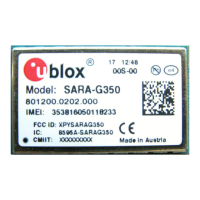SARA-G3 and SARA-U2 series - System Integration Manual
UBX-13000995 - R26 System description
Page 96 of 217
Device including SARA-U2
SAP
Serial interface
(SAP channel over
USB or UART)
GSM/UMTS
interface
Local SIM
(optional)
SARA-U2
SAP client
Application
processor
SAP
Bluetooth
interface
Bluetooth
Transceiver
Device including SIM
Remote SIM
Mobile
Equipment
SAP Server
Bluetooth
transceiver
Figure 39: Remote SIM access via Bluetooth and wired connection
The application processor can start an SAP connection negotiation between SARA-U2 module SAP client and an
SAP server using custom AT command (for more details, see the u-blox AT Commands Manual [3]).
While the connection with the SAP server is not fully established, the SARA-U2 module continues to operate
with the attached (local) SIM, if present. Once the connection is established and negotiated, the SARA-U2
module performs a detach operation from the local SIM followed by an attach operation to the remote one.
Then the remotely attached SIM is used for any GSM/UMTS network operation.
URC indications are provided to inform the user about the state of both the local and remote SIM. The insertion
and the removal of the local SIM card are notified if a proper card presence detection circuit using the SIM_DET
pin of SARA-U2 modules is implemented as shown in section 2.5, and if the related “SIM card detection” and
“SIM hot insertion/removal” functions are enabled by AT commands (for more details, see the u-blox AT
Commands Manual [3], +UGPIOC, +UDCONF=50 AT commands).
Upon SAP deactivation, the SARA-U2 modules perform a detach operation from the remote SIM followed by an
attach operation to the local one, if present.
1.13.23 Power Saving
The power saving configuration is by default disabled, but it can be enabled using the AT+UPSV command.
When power saving is enabled, the module automatically enters the low power idle mode whenever possible,
reducing current consumption.
During low power idle mode, the module is not ready to communicate with an external device by means of the
application interfaces, since it is configured to reduce power consumption. It can be woken up from idle mode
to active mode by the connected application processor, by the connected u-blox positioning receiver or by
network activities, as described in Table 5.
During idle mode, the module processor core runs with the RTC 32 kHz reference clock, which is generated by:
The internal 32 kHz oscillator, for SARA-G340, SARA-G350 and SARA-U2 modules
The 32 kHz signal provided at the EXT32K input pin, for SARA-G300 and SARA-G310 modules
SARA-G300 and SARA-G310 need a 32 kHz signal at EXT32K input to reach the low power idle mode.
For the complete description of the AT+UPSV command, see the u-blox AT Commands Manual [3].
For the definition and the description of SARA-G3 and SARA-U2 series modules operating modes, including the
events forcing transitions between the different operating modes, see section 1.4.
For the description of current consumption in idle and active operating modes, see sections 1.5.1.4, 1.5.1.5.
For the description of the UART settings related to module power saving configuration, see section 1.9.1.4.
For the description of the USB settings related to module power saving configuration, see section 1.9.3.2.
For the description of the EXT32K input and related application circuit design-in, see sections 1.6.4, 2.3.3.

